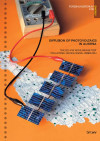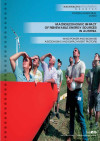Suchergebnisse
Energy-self-sufficient district Güssing
Development of a concept that shows the possibility of changing the energy supply of a district from fossil to 100% renewable energy carrier
Photovoltaic Roadmap for Austria
Development of a Photovoltaic Roadmap for Austria - a study with the intention to screen the opportunities, economical potential as well as the barriers of the promising technology Photovoltaics as basis for strategic decisions in energy relevant policies.
Photovoltaic - Industry and Research in Austria

This brochure examines the existing domestic value creation in the field of photovoltaics and provides an overview of the Austrian research landscape, along with open research questions related to photovoltaic technology.
Herausgeber: Austrian Photovoltaic Technology Platform - TPPV supported by BMK (2024)
Englisch, 13 Seiten
Downloads zur Publikation
Fair market conditions for virtual power plants
Analysis of technical, economical and regulatory conditions to get fair terms under competition in the liberalised market for virtual power plants on renewable energy basis.
IEA SHC Conference and ISES Solar World Congress 2017
29. October - 2. November 2017
Jumeirah Hotel at Etihad Towers, Abu Dhabi, United Arab Emirates (UAE)
The International Solar Energy Society, ISES, and the International Energy Agency’s Solar Heating and Cooling Programme, IEA SHC, are very pleased to announce that their next international conferences, the ISES Solar World Congress 2017 (SWC 2017) and the Solar Heating and Cooling for Buildings and Industry Conference (SHC 2017) will be held together.
Virtual power plants for self-sustaining regions
Geographic methods for the combination of renewable energy sources to create "virtual power plants" and development of self-sustaining regions in terms of energy-balance and the Kyoto target.
Technology Platform Photovoltaic Austria
Between research institutions and the economic system the way has been paved to initiate joint R&D projects. Common research activities have been initiated and intensified to be able to position local companies in international niche markets for photovoltaics.
Study of the Potential of Popcorn-Technologies for the Austrian Energy System
Schiestlhaus, Hochschwab

An integrated (overall) concept for an ecological alpine refuge hut based on solar energy
IEA Photovoltaic Power Systems (PVPS)
Enhance the international collaborative efforts which facilitate the role of photovoltaic solar energy as a cornerstone in the transition to sustainable energy systems. The IEA PVPS programme aims to realise its mission through objectives related to reliable PV power system applications, contributing to sustainability in the energy system and a growing contribution to CO2 mitigation.
Virtual power plants and DSM
For the cost efficient and lasting energy supply from ecological sources, wind, photovoltaic and biomass have to be integrated in existing grids. New methods for DSM and virtual power stations are investigated, to improve the control behaviour.
Photovoltaics In Buildings

International research cooperation within the framework of the IEA program "SOLAR HEATING& COOLING"
Forschungsforum
1/1997
Herausgeber: BMVIT
Englisch, 6 Seiten
Downloads zur Publikation
Innovative Energy Technologies in Austria Market Development 2014

The market development of the examined technologies was restrained or marked by decreasing figures in 2014. An exception was the area of wind power. The use of solid biogenous fuels was reduced in 2014 due to an exceptionally mild heating period. The sum of the heating degrees for 2014 war 21 % less than the longtime average.
Englisch
IEA PVPS Task 12: Photovoltaics Sustainability (working period 2018 - 2021)
The aim of IEA PVPS Task 12 is to foster international collaboration in the area of photovoltaics and environment. That includes compiling and disseminating accurate information on environment, health, safety, and other aspects of sustainability associated with the life-cycle of photovoltaics. Results are guidelines and data basis in order to harmonize LCAs and studies on future environmental impacts of PV and PV recycling. The Austrian contribution addresses LCA and implementation of sustainability aspects.
IEA PVPS Task 12: PV Environmental Health And Safety (working period 2016-2018)
The aim of IEA PVPS Task 12 is to foster international collaboration in the area of photovoltaics and environment. That includes compiling and disseminating accurate Information on environment, health, safety, and other aspects of sustainability associated with the life-cycle of photovoltaics. The austrian contribution addresses LCA, implementation of sustainability aspects and dissemination.
IEA PVPS Task 12: Photovoltaics (PV) Sustainability Activities (working period 2024 - 2027)
Photovoltaics (PV) is a renewable energy source that is an important technology for the energy transition. For this reason, or rather despite this, it is important to consider sustainability aspects in PV as well. End-of-life solutions in particular play an important role, as a strong increase in the number of end-of-life modules is expected in the coming years. Well-functioning recycling methods, repair possibilities or reuse options are of great importance. In this project, these existing methods and capacities in Austria are being researched and published in reports and workshops.
Diffusion Of Photovoltaics In Austria

The 200 KW Wide- Range Test Collateral Sociological Research
Forschungsforum
2/1998
Herausgeber: BMVIT
Englisch, 6 Seiten
Downloads zur Publikation
aspern Vienna´s Urban Lakeside - subproject 3a: Technology Centre aspern IQ
The demonstration project "Technology centre aspern IQ" showed that the energy required for space conditioning (heating, cooling, ventilation, lighting, hot water) can be covered from domestic energy production.
Macroeconomic Impact Of Renewable Energy Sources In Austria

Wind Power and Biomass as Economic and Employment Factors
Forschungsforum
2/2003
Herausgeber: BMVIT
Englisch, 6 Seiten
